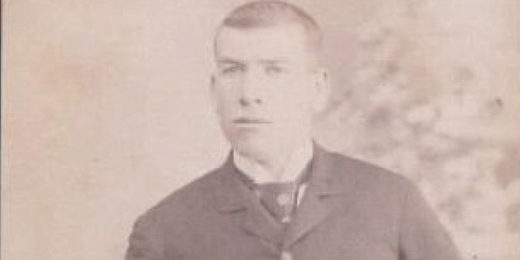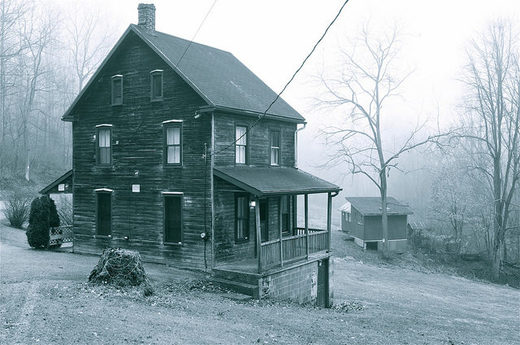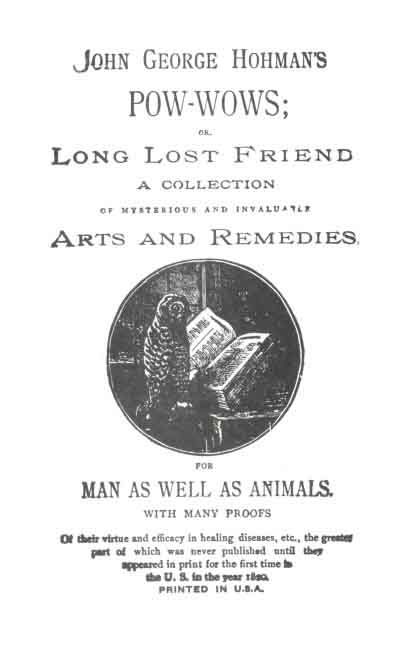
COHEN: Do you think it is right to kill a person who has you bewitched?One of the most commonly-told urban legends in the Lancaster/York county area of Pennsylvania to which I'm native deals with a locale known as Hex Hollow, or, more properly, Rehmeyer's Hollow. As is the case with most urban legends, the stories about this place vary from teller to teller. The most common, however, is that a man named Rehmeyer, a known Satanist and black magician, conducted a series of human sacrifices in his house. After the magician died or was killed (again depending on the teller), his house was set on fire but refused to burn.
BLYMIRE: Why, I think it is right, yes, if a fellow has me bewitched.
COHEN: If the judge of this court had you bewitched, would it be right for you to kill him?
BLYMIRE: If he had me bewitched.
Conversation between attorney Herbert H. Cohen and John Blymire, from the trial transcript of the Rehmeyer case.
The truth of the matter is quite different, but elements of it can be seen in the legend above. In fact, it was discovered that whereas many people in York County were familiar with the Hollow legends, a surprisingly (and depressingly) small percentage of those were familiar with the history of exactly what occurred there. To discover what actually did, we must cast our minds back to 1928, to a time when the county was even more rural than it is now - and scarcely anywhere was more rural than Rehmeyer's Hollow, a heavily-wooded tract occupied by a scant few farms, almost all of which were inhabited by the Rehmeyer clan or close relations. The Hollow still feels this way today - pleasant during the day, shockingly dark (no street lights line its roads) at night.
In one of the cabins lived Nelson Rehmeyer. By all accounts a large man, tall and thin, he was a reclusive man of modest means, raising potatoes and corn on his small farm. Nelson was also well-known in the area as a braucher. Brauch or braucherei, usually known as pow-wowing, is a system of folk medicine practiced among the more rustic residents of the Appalachian region. As described in John Hohman's book "The Long-Lost Friend" (seen as the "Bible" of pow-wow magic), it prescribed unlikely "cures" for everything from physical ailments to livestock ills. Many of Pennsylvania's residents, particularly rural residents far from towns, would (and some perhaps still do, though considerably less than before the hex killings) sooner consult a pow-wow "doctor" than a physician. Many pow-wow doctors would charge a fee to conduct some ritual or other to cure whatever ills or misfortunes the patient complained of (or, occasionally, give the patient instructions on how to proceed). They also produced magic charms known as himmelsbrief, small pieces of paper, often with some Biblical verse or another written on them, meant to protect the bearer. Several American soldiers in World War I was found to have himmelsbrief in the pockets of their coats.
In York city there lived another man who was to become central to the events of 1928, John Blymire. Blymire was a distant relation of Nelson's and, like him, was a pow-wow. One well-known event of Blymire's life came when he calmed a mad dog which was about to attack several of his co-workers at a local cigar factory. However, at some point Blymire began to suffer bouts of insomnia, growing more and more tired and listless. His pow-wow powers weakened and eventually disappeared entirely. He began to see visions of all manner of supernatural beings in his dingy apartment. He conducted rituals to cure himself of his ailments. These failing, he began to become convinced that he was cursed by some individual who wished him ill. He consulted all manner of other pow-wow doctors, among them a man named Andrew Lenhart, in a vain attempt to find the malefactor.
First becoming convinced that he was cursed by the spirit of his grandfather, Jacob, John's hallucinations and delusions of persecution grew stronger by the day, and eventually, his wife began legal proceedings to have him placed in a mental health facility. He was placed in the State Hospital at Harrisburg; however, after only a few months, Blymire simply walked out of the notoriously under-secure hospital and made his way to York, reputedly to murder his wife. He resumed his job at the cigar factory. While here, he met two younger men who likewise believed they were cursed - 14-year-old John Curry and a man named Milton Hess. Curry had a troubled home life and believed an evil force was responsible for his plight (likely influenced by Blymire, whom he idolized), while the farm belonging to Hess' family had fallen on hard times and was likewise believed to be cursed by a neighbor.
Once he heard the stories of his two co-workers, Blymire was more convinced than ever that there was a follower of hexerei or hexeria somewhere in the area. Hexerei was the polar opposite of braucherei - while using the same charms and rituals as pow-wow, they were meant to inflict, rather than to cure. Still consulting other practitioners, he soon consulted a woman in the town of Marietta named Nellie Noll (real name Emma Knopp), who lived in a small apartment in the rear of a house on Front Street, giving her the nickname "The River Witch." Noll conducted a ritual in which Blymire was to stare at a dollar bill for a specified time and then look at his hand - his palm would show the face of the curse-layer. Most likely simply an illusory afterimage effect, Noll's spell nonetheless showed Blymire a face - the face of Nelson Rehmeyer. At last, he knew who the hexer was. Noll told him that if he could procure the hexer's copy of "The Long-Lost Friend" and a bit of his hair, and bury both these items six feet underground at the corner of the Hess farm, this would lift both Hess' and Blymire's curses. Easy!
On November 26, 1928, John Blymire and John Curry made their way to Nelson's farm near Shrewsbury. Blymire talked with the elder man for a long while, and when Rehmeyer went to bed they searched his house but failed to find the book. Blymire's two companions expressed doubt that they could procure the hair they needed, since Rehmeyer, as mentioned earlier, was a large man. The next day, John Blymire purchased some lengths of rope, and that evening they returned to the Hollow.
He managed to convince Hess that a member of his family needed to aid in obtaining the items - Milton sent his 18-year-old son Wilbert (not Wilbur, as is often reported). This time, they tackled Rehmeyer and tied his hands and feet. Here the testimony given in the ensuing trial becomes confused and muddled. The three began to beat Rehmeyer viciously and strangled him with a piece of rope. Then, according to Blymire, Hess and Curry doused the now-deceased farmer in lamp oil and set his body aflame and all three left the house.
The fire, however, sputtered out and consumed neither Nelson's body nor the wooden farmhouse. A few days later, one of the neighboring farmers went to the house to check on things, for one of the mules kept on the premises was being noisy as if it had not been fed. He found Nelson's partially-burnt body in a house which had sustained relatively minor damage. The murder reported, the testimony of Nelson's ex-wife Alice led to the arrest of Blymire, Curry, and Hess.
Some interesting details were revealed in the testimony presented by the various parties during the trial. Blymire recalled that, while near the barn formerly attached to the Rehmeyer house (though no longer present) he looked back. "When we got to the barn, we looked back and I said, 'There's something standing in the road.' They said it was a shadow of something." This detail was backed up by the testimony of Curry, who said "Blymyer [the name can be spelled either way] come to the conclusion that the house wasn't burning. He said, 'Let's go back.' So we went back, and when we got to the barn, Blymyer and Hess thought they saw somebody standing in the road." It is also brought up fleetingly by Hess, who says in his testimony that "Then I said that I believe that someone is coming down the road..." Interestingly, there are several ghostly phenomena said to take place at the house and farm, one of which is figures in the road or surrounding woods.
What exactly happened that night is still unclear. All three defendants are long-since deceased. As mentioned, Blymire lay the blame for the murder solely on Curry and Hess. Curry laid the blame solely on Blymire. Hess lay the blame on Blymire and Curry, although he admitted some part in the slaying.
Speaking as an outside observer, I'm tempted to believe Hess' version of events. Some of Blymire's statements - notably the one which opened these paragraphs - were damning, and if he did indeed intend to murder his wife, that's even more so. Curry seemed a bit manipulative of the older, but very likely mentally deficient, Blymire and it's possible the teenager may have goaded him into action.
In any case, all three were released and lived out normal lives in York County - as normal as could be expected from murderers, at any rate. Blymire was released in 1953 and lived the remainder of his life as a night watchman in Philadelphia. Curry was released from prison in 1938, joined the Army during World War II and retired to a farm in York County. Hess was released the same year and worked the rest of his life in a factory.
The 1928 Rehmeyer slaying served to redouble Pennsylvania's efforts to stamp out pow-wow which it had begun in 1911 after a number of people died from seeking the services of brauchers rather than physicians. The efforts continued in the following years, as a number of other sensational - at least in the local press - cases took place.
A sinister cast over the events of the Rehmeyer murder, not a possibility raised in the trial, is suggested by the 1922 shooting death of Irving Heagy, who had hired Andrew Lenhart - one of the pow-wowers consulted by Blymire - to rid his home of a hex. Heagy's wife, Sallie, was most sorely afflicted by the hex and felt that Lenhart was not effective in his cleansing of the house. Somehow, this translated into a need to kill her husband, rather than the "witch" who failed. And in June 1928, just a scant few months before the Rehmeyer murder, another of Lenhart's clients also murdered her husband. Three clients of the same man, all of whom committed murder? Was Lenhart subtly influencing his "clients" to kill? A sobering, sinister possibility.
A few months after the murder in the Hollow, in March 1929, a dead woman was found in the woods near Catasauqua. She bore in her pockets several scraps of paper with protective charms scrawled on them - himmelsbriefs - and the fledgling science of toxicology identified several poisonous substances in her system. She was soon identified as Verna Delp, and her adoptive father revealed that she had been consulting a pow-wow doctor named Charles Belles. Belles at first denied knowledge of the girl, and later recanted and admitted treating her. He denied any part in her death, however. This was later confirmed when it was found she was pregnant, and with her boyfriend no longer in the picture, it was determined that rather than tell her family she elected to try to end the pregnancy and ended up inadvertently killing herself. The courts still arrested Belles, who later was released from prison and the murder charges against him dropped.
In January 1930 another case of "hex hysteria" occurred, this time in Reading. A Mrs. Harry McDonald died of burns in her home. An ointment of some sort, given to her by a local pow-wow doctor, was found in her home. With no evidence other than growing distrust of pow-wowers - often disparagingly referred to as "voodooists" by the press - her brother advanced the notion that the ointment was somehow responsible for her death. As far as can be determined, the doctor in question was never identified.
In January 1932 an accountant by the name of Norman Bechtel was found on the grounds of an estate near Germantown, in Philadelphia. Bechtel had a number of mysterious wounds - a ring of nine puncture wounds encircled his heart, and an intricate web of cuts forming a bizarre pattern covered his face. This was quickly seized on by the press as another "hex murder," particularly once it was discovered that Bechtel was a native of Boyertown, near Reading, a hotbed of pow-wow activity. Five years later, William Jordan confessed that he and five other men had murdered Bechtel in a failed blackmail attempt. But as there was no explanation by Jordan of the obviously deliberate wounds, I think his guilt is doubtful.
A second true hex murder took place in March 1934. A woman and known pow-wower named Susan Mummey, also known as Old Suss, was shot in her home near Shenandoah. The murder was reported by the other two people in the house at the time, but the police were without any real leads until a young man barely in his twenties came forward and confessed that he had slain Old Suss. Albert Shinsky (or Yashinsky, depending on the account) said that he was afflicted by a ghostly black cat with burning eyes which materialized out of sharp objects. He was obliged to climb into his bedroom through the window because if he trod on the stairs the wrong way, the cat would appear and attack him. The cat would crawl in his room and claw him while he slept. He was eventually able to determine that Old Suss had cursed him, and so he shot her. Apparently, it didn't work, since even in prison Yashinsky complained of the cat's visits. He was eventually confined to a mental facility.
Philadelphia was a hotbed of false "witch" crimes. A different sort of hex crime - and one in which any witchcraft or ritual component is highly doubtful - came to light in 1938 with the death of Ferdinando Alfonsi, an Italian immigrant, who was found after his death to have in his system massive amounts of arsenic. An insurance policy taken out on Alfonsi was eventually traced back to Paul Petrillo, and from there it unfolded on a huge scale. A massive scheme was being perpetrated by the so-called "Poison Ring," setting uneducated Italian immigrants up with arranged marriages, arranging for large insurance policies to be taken out on said immigrants, then murdering the immigrants. The leaders of the Poison Ring then collected the profits. All in all a sordid scheme, and one without any perceivable hex component. Several of the leaders, however, among them Morris Bolber and Rose Carina, the "Kiss of Death Woman" were reputed to have magical powers of hexcraft. It's doubtful any did, and it was likely merely a ploy to frighten prospective black widows (and, in at least one case, black widowers) into compliance. The full investigation took three years. There were 14 arrests and 114 individual murders were laid at the feet of the Poison Ring.
Another false witch crime - the last Pennsylvania case with which I'm familiar, and one about which precious little information is known - took place in 1941. An Italian housewife, Mrs. Michael Menichella, found her infant daughter dead in the basement of the Menichella home in the Tacony section of Philadelphia. All the Menichellas were questioned, and suspicion eventually fell on the father, Michael. During questioning, he provided an unbelievable story - several witches, accompanied by a gigantic black dog, broke into the home, killing the baby. Detectives, understandably, were far from convinced. Michael eventually broke down and confessed - partially. He now revised his story, but if anything, it got even stranger. He maintained insistence that the witches and the black dog entered the home - but now, in an effort to protect his family, he himself turned into a black dog. In his words, "Anything after that must have been the dog." An admission? To which "dog" was he referring? A rather ingenious way to confess but not confess. However, as is the case so often with news stories in older papers, here the trail runs cold. No further mention is made of the case after this "confession." I managed to find a record of Michael Menichella's death, two decades later, still in Tacony. What had happened to him in the meantime, however, remains a mystery.
COHEN: Since Rehmeyer's head with his hair is buried eight feet under the ground, do you feel better?
BLYMIRE: Yes, sir.
COHEN: You do feel better?
BLYMIRE: I can eat, sleep, and rest.
Conversation between attorney Herbert H. Cohen and John Blymire, from the trial transcript of the Rehmeyer case.






Reader Comments
to our Newsletter